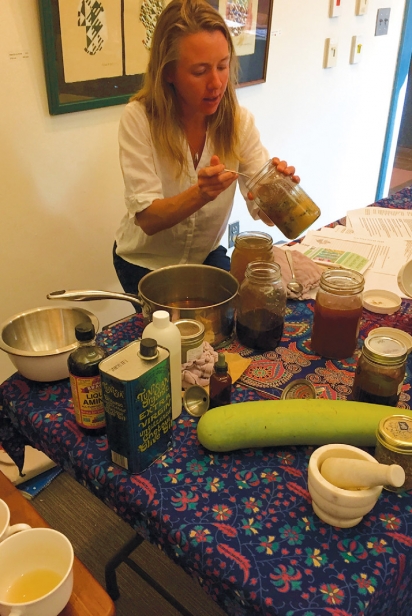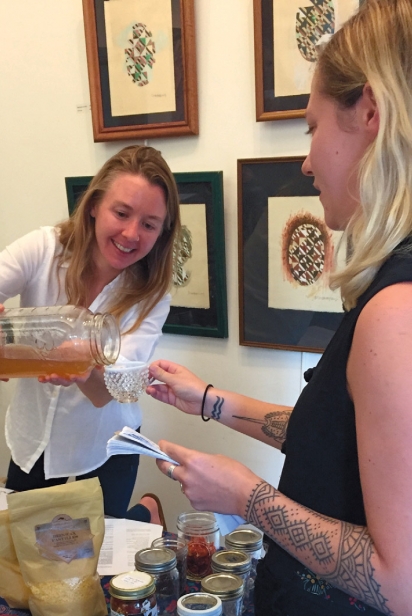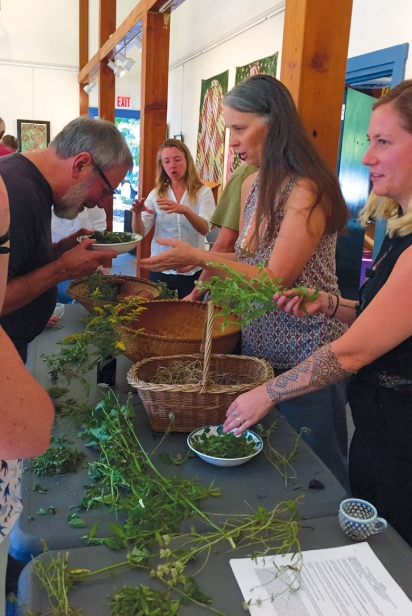Making Medicine
Connecting to Earth’s Wisdom
Sarah Naciri is on a quest to balance, calm and heal others using things found in nature.
“It’s not that long ago,” Naciri says, “that we understood the value of preparing medicine from plants. There is record of nearly all indigenous and ancient cultures receiving information from the plants themselves about the healing properties that they contain. It isn’t one single school of thought that I look to for gaining knowledge. We can learn from the Wampanoags and other native peoples, traditional Chinese medicine, practices of the Europeans, Ayurvedic traditions and many others.”
Raised in a suburb of Philadelphia, Naciri’s love for the Earth was introduced by experienced gardeners on both sides of her family. “My dad was a chef and a high school culinary arts educator. He raised luscious perennial plants and we had deep shade gardens on our property. We made an effort to compost. Our family car was most always transporting horse manure and veggie scraps. There was ‘flow’ going on.
“My maternal grandmother,” says Naciri, “grew up on a farm with horses and incredible vegetable gardens. My mother was one of seven sisters in a nine-sibling family. Those young women were real makers who quilted, sewed, wove baskets and tended to the land. In time they became powerful women with careers like teaching and social work.”
Naciri says of her mom, currently director of Human Services in Barnstable County, “She has always been a powerful activist and helped lead me towards an education and career involved with both food as medicine and social justice.”
Naciri experienced firsthand the healing power of local plants while still a teen. “It was more of a desire to understand how to healthfully fuel myself. I knew that I needed greater nourishment and healing from my food. I fell in love with nutritional studies after reading Paul Pitchford’s Healing with Whole Foods, and Sally Fallon’s Nourishing Traditions. I began a yoga practice studying with a teacher alongside both my parents. There was a real seeking in my body for greater connectedness. I also started to meditate,” says Naciri.
Naciri entered Smith College, studying art history, sociology, geology, biology, and a subject she continues to be fascinated with, ethnobotany, the study of regional customs in the practical use of local flora by different societies. Although she enjoyed the school, she departed after a single semester. “It was not my time to be in that rigorous and very competitive environment.”
She and a friend travelled for six months exploring India and studying Ayurvedic medicine and farming. As members of WOOF (Worldwide Organization of Organic Farms), they experienced home-stays at three different locations where half a day’s labor was exchanged for simple room and board.
“We were near the border of Nepal at one point, so we would trek nine to ten hours through the Himalayas learning about local plant life from an experienced guide we had hired. I can remember perfectly the people, places and smells from that time. We foraged for most of our food while hiking, surrounded by the beauty of nature,” says Naciri. “This trip had a profound effect on me.”
Returning to Smith, Naciri focused on sustainability, taking many classes at both Hampshire College and UMass Amherst. Before graduating, but ready for a simpler existence, she moved to the Pioneer Valley of Massachusetts. The soil was mineral rich, there were a dozen small organic farms and a vibrant market life. She helped provide surplus food from these farms twice weekly to residents in public housing, teaching the community how to prepare veggies like kale and swiss chard healthfully.
While working on the land, Naciri discovered she was more interested in “the vibrant patches of nettles, fields of red clover, gigantic burdocks on the edge of the fields, than in the plants we were cultivating. I found myself indulging in chickweed, purslane, dandelions, and lamb’s quarters while ‘weeding,’” she says.
Naciri says, “For me it was remarkable to tend to these basic things in my twenties. It gave me the space to experience myself, to heal and to find balance and peace and wellbeing. It was during this incredible time in nature that I surrounded myself with books. My desire to learn plant medicine grew and it was my time to experience communicating with plants.”
Specifically, Naciri’s focus now is learning about and implementing regional species that have therapeutic value and have been used traditionally by native peoples. A few years ago when her parents relocated to the Cape to be near her grandmother, Naciri soon followed their move, bringing her daughter, Leela Okeanos, now 3½ , to the outer Cape. Enamored of her new home and the Cape community, she wants to use the rich plant life available locally in her medicines and to teach her friends and neighbors how to do the same.
Sharing her knowledge in seasonally-themed workshops open to all. Winter sessions feature tree and lichen work, a love of Naciri’s. She has completed several monographs of local trees for in-depth study. The water or kidney element in traditional Chinese medicine and ferments will also be highlighted. Spring themes center on what is sprouting and forageable locally, as well as what plants we should be able to begin cultivating. Learning is hands-on and comprehensive, with many of the participants being equally engaging, well-learned and enthusiastic about the practical role of plants in our lives.
At one of Naciri’s events you will find portable tables surrounding the perimeter of rows of chairs. Thoughtfully grouped items gathered from land and sea rest on each table, nestled by utensils—perhaps a hefty cleaver, a grater or a tiny spoon. Rich colors and textures, both familiar and obscure, of baskets, bowls and textiles compose each grouping. Scents drift and overlap; sweet, pungent, inviting, repelling or evocative. Naciri moves to the front of the room sipping herb tea from a grand mason jar, ready to begin.
Diminutive in stature, yet commanding with a presence of both ease and intention, Naciri ushers all to come in close. Now told to finger the leaves and berries, smell the blossoms, and examine roots, we explore what is set before us. Naciri speaks with an absolute reverence for each plant, addressing each as “our friend chicory,” or “our friend astragalus.” Soon elbow to elbow, each of us smells, dices, strips, chops or measures, working at the specific table whose components have called to us most strongly, for reasons we may not yet, or ever, know.
At the front table from where Naciri speaks is another still life. This time it’s liquids of varying hues and viscosities in her collection of “keeper” jars, recalling the lively potions of Harry Potter. Naciri reviews best practices for preparing teas from locally gathered herbs: dry herbs completely before storing to prevent mold, and freshly brew each morning the volume of tea you will enjoy throughout the day.
“In my work I encourage people to eat wild food that is as clean as one can hope for, as often as they can,” says Naciri. “I support wild foods because they are mineral rich and nutrient dense. They help to detox and cleanse our organs, and they support our bodies nutritionally.”
Naciri admits to also being very conscious of the electromagnetic energy increasingly surrounding us each day, and wonders of its effects on our health. A longtime supporter of food grown without pesticides, she is troubled by the rise of genetically modified foods and of chemicals in our food and water.
Consumers find they often spend more when buying organics and other very beneficial foods. Naciri finds this an important question to ask ourselves. Should one channel money into food that builds nutrition? Portions may need to be adjusted smaller for some items so that we can eat actual food that was raised, grown to maturity, and harvested near our homes. It may also require more work for us to create, for example, a bone broth from local pasture-raised meat than to open a carton of stock.
She persists that the cost and effort involved is worth it, sharing a story of her young daughter clamoring in the mornings for more spirulina (a freshwater alga containing protein, iron, amino acids and antioxidants like beta-carotene). Says Naciri, “She has had the positive experience of receiving pure energy from food.”
Naciri explains that many local plants have powerful healing properties and can be used alone or in conjunction with allopathic or more conventional treatments like surgery and drugs. She’s treated cuts, scrapes, dry skin, abrasions, wounds, bruises, inflammations, fractures, dental pain, ear infections, gut health, immunity system restoration, cancer and the effects of radiation, pregnancy, labor, postpartum care and internal ulcers, all with plant therapies. Naciri says, “If working with an herbalist, be sure to bring your blood work and MRI results along so that you can receive truly holistic care.”
Rather than having to run to the doctor for handling basic colds, flus and fevers, Naciri loves inspiring people about how to handle symptoms with basic foods and plants. She says, “I love focusing on safe herbs for children and babies.”
Actively making plant medicines now for 14 years, Naciri has learned that as her knowledge increased so also did her ability to communicate with the plants themselves. When she finds herself acutely present and her observation skills at their keenest, Naciri says, “there is an analytical part of me that softens, and I have a greater ability to be receptive. I can almost hear the plants calling out, telling me which ones would be the best ‘allies’ for a particular individual I may be working with to become familiar with, use as medicine and apply topically and/or to consume. Everything comes in its own time.”
What Naciri says she truly teaches are skills of observation. “I take people outside, to see the air moving, next asking them to name the direction of the wind, and then I point out the fullness of the pine needles.”
“Working with me as your community herbalist, one-on-one, is at its core, a solid respective connection with no office or contracts,” says Naciri. “It can’t work with everybody, it must be just right. When people sit with me for individual sessions, they get my experience, I take it all in. Hair, skin, eyes, and their tongue. This is beautiful vibrant information speaking to me.”
Equally as entranced by the wonders of the sea as she is of the land, Naciri says, “Every one of us begins our life in an ‘ocean’ of saline solution. Remember all the abundant plant and animal life that is available to us in the sea, plus micro algae that is somewhere between the two.”
Sea vegetables are frequently higher in nutrients than vegetables grown on land, many being loaded with calcium, iodine and chlorophyll. Naciri harnesses the power of seaweeds and sea plants to cool, moisten and soothe the GI tract and lungs, as well as to break up masses and heal after radiation.
Naciri gathers a bit of bladderwrack seaweed and sea lettuce for her family if she finds it on the beach, but relies often on the skills of Larch Hanson (theseaweedman.com), who has gathered and dried seaweed daily from a remote area off coastal Maine for over 40 years. Simmering some with a touch of ginger in broth, adding others to hearty soups, beans and stews, she also nibbles certain varieties raw. “Obtain what you need from the places you have confidence in,” suggests Naciri.
One thing most of us can do to try to eat food that is more healthful and to use plants that are medicinal, is to garden. “I encourage people to just start and grow around their houses,” says Naciri. “My own focus in the years to come will be to grow more things year-round outdoors, to teach my neighbors to do the same, and also how to make super nutritive medicine from the food and plants that they grow.”
Tea is a simple way to introduce the many botanical health benefits that can be made available to us after steeping the petals, roots, berries, leaves and/or bark of various plants. Naciri forages for the Cambridge, Massachusetts-based Tea is the Way (teaistheway.com), a source and blender of locally farmed and gathered plant varieties. She notes elderberries, cherry bark and sassafras root, and adores Rosa rugosa tea, known for its superior vitamin C content, and gathers the blossoms in August.
Naciri champions the wondrous immunity-modulating qualities of mushrooms, urging all to indulge in locally-raised varieties from a source like farmer Uli Winslow, who inoculates logs at his Truro location. He sells at local farmers’ markets and occasionally at Truro Vineyards. Prepare and enjoy a bowlful of mushrooms per person each week, she advises, always cooked, to fully reveal the many benefits they possess.
As Naciri considers the world, she sees the degradation of our environment and communities, yet she is one to find much to cherish and wonder about in all she encounters. “I’m very aware of the past, present and future, and the connectiveness of time. For the healing of the planet and us as a species, we must realize our innate interconnectedness; that we are each part of one another and of all beings,” she says.
“It’s amazing the ripple that just a single human being’s actions can create. Each one of us can have an impact so that greater health is manifested in our own lives, we can advocate for our elders and we can teach our children. We need more collaboration,” says Naciri. “Together, all of us can appreciate this beautiful world and I want to be a part of that.”







